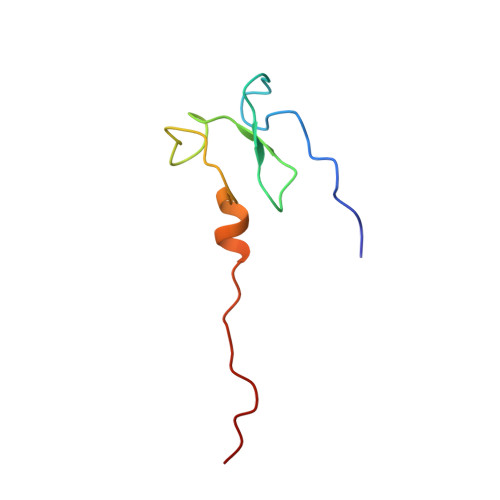NMR structure of the first PHD finger of autoimmune regulator protein (AIRE1). Insights into autoimmune polyendocrinopathy-candidiasis-ectodermal dystrophy (APECED) disease
Bottomley, M.J., Stier, G., Pennacchini, D., Legube, G., Simon, B., Akhtar, A., Sattler, M., Musco, G.(2005) J Biol Chem 280: 11505-11512
- PubMed: 15649886
- DOI: https://doi.org/10.1074/jbc.M413959200
- Primary Citation of Related Structures:
1XWH - PubMed Abstract:
Mutations in the autoimmune regulator protein AIRE1 cause a monogenic autosomal recessively inherited disease: autoimmune polyendocrinopathy-candidiasis-ectodermal dystrophy (APECED). AIRE1 is a multidomain protein that harbors two plant homeodomain (PHD)-type zinc fingers. The first PHD finger of AIRE1 is a mutational hot spot, to which several pathological point mutations have been mapped. Using heteronuclear NMR spectroscopy, we determined the solution structure of the first PHD finger of AIRE1 (AIRE1-PHD1), and characterized the peptide backbone mobility of the domain. We performed a conformational analysis of pathological AIRE1-PHD1 mutants that allowed us to rationalize the structural impact of APECED-causing mutations and to identify an interaction site with putative protein ligands of the AIRE1-PHD1 domain. The structure unequivocally exhibits the canonical PHD finger fold, with a highly conserved tryptophan buried inside the structure. The PHD finger is stabilized by two zinc ions coordinated in an interleaved (cross-brace) scheme. This zinc coordination resembles RING finger domains, which can function as E3 ligases in the ubiquitination pathway. Based on this fold similarity, it has been suggested that PHD fingers might also function as E3 ligases, although this hypothesis is controversial. At variance to a previous report, we could not find any evidence that AIRE1-PHD1 has an intrinsic E3 ubiquitin ligase activity, nor detect any direct interaction between AIRE1-PHD1 and its putative cognate E2. Consistently, we show that the AIRE1-PHD1 structure is clearly distinct from the RING finger fold. Our results point to a function of the AIRE1-PHD1 domain in protein-protein interactions, which is impaired in some APECED mutations.
Organizational Affiliation:
Istituto di Ricerche di Biologia Molecolare P. Angeletti, Via Pontina Km. 30.600, 00040 Pomezia (RM), Italy.















